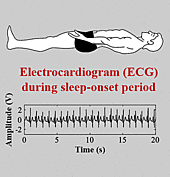
Da Woon Jung, Su Hwan Hwang, Yu Jin Lee, Do-Un Jeong, and Kwang Suk Park, Seoul National University, Korea
With the increase in obesity and the ageing population, obstructive sleep apnea (OSA) has been considered a serious clinical concern. For the cost- and time-efficient identification of OSA patients, various clinical and anatomico-functional predictors have been suggested. However, all existing OSA predictors have limitations, as they provide only binary classification without considering multiple categories of OSA severity determined by the apnea-hypopnea index (AHI) value. The aim of our study was to propose a new predictor of AHI.
We hypothesized that less irregular respiration cycles would be observed in the patients with more severe OSA during the sleep-onset period. Using each of the 156 and 70 single-lead electrocardiogram (ECG) recordings collected from the internal polysomnographic database and the Physionet Apnea-ECG database, respectively, the 150-s sleep-onset period was determined and the respiration cycles during this period were detected. By utilizing the coefficient of variation of the respiration cycles, obtained from the internal dataset, as a predictor, the AHI prediction model was developed through regression analyses and k-fold cross-validation tests. The AHI predictability of the regression model was assessed with the Physionet Apnea-ECG database. The regression model trained and validated with the data of the 143 and 13 recordings, respectively, exhibited an absolute error (mean ± SD) of 3.65 ± 2.98 events/h and a Pearson’s correlation coefficient of 0.97 (P < 0.01) between the AHI predictive values and reference values for the test set including 70 recordings. The new predictor of AHI could be potentially useful to make more reasonable clinical decisions on the need for formal diagnosis and treatment of OSA. Our study is the first to present the strategy to provide a reliable AHI without overnight recording.
Keywords: autonomic dysfunction, apnea-hypopnea index, electrocardiogram, obstructive sleep apnea, respiration cycle, sleep-onset period

